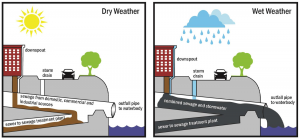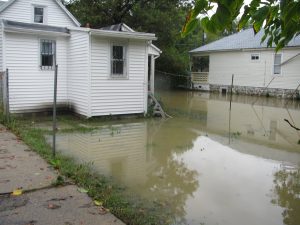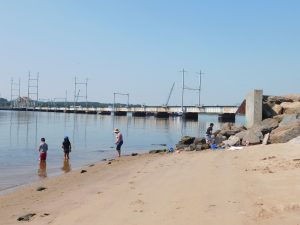
When it rains in 21 New Jersey cities and towns with combined sewer systems, raw sewage pours into rivers and backs up into basements and onto streets. This is known as a combined sewer overflow (CSO). An estimated 23 billion gallons of a mixture of raw sewage and stormwater are dumped annually into New Jersey’s waterways as a result of CSOs.
In 2015, the New Jersey Department of Environmental Protection (NJDEP) issued a permit that required these communities to develop plans by October 2020 to reduce sewage in nearby waterways. Implementing these plans will cost billions of dollars over the coming decades and will have significant effects on residents and business owners for generations to come.
THE IMPACTS OF COMBINED SEWER OVERFLOWS
On neighborhoods:
Localized flooding in streets and into basements is disruptive to residents and businesses, and can contain dangerous bacteria, leading to contamination of drinking water supplies.

The 21 municipalities with combined sewer systems are affected by private sector disinvestment and a history of environmental contamination from industry. Environmental problems from industry and combined sewer overflows have had a disproportionate impact on residents with lower incomes and communities of color.
While there are robust public outreach efforts in some places, these efforts are not being made everywhere, leaving many people who work, live, and own businesses in these cities in the dark.
On the economy:
The cost to upgrade these systems — the biggest infrastructure investment that some of these communities will make in a generation — will be paid for by residents and businesses.
Most combined sewer systems are located in growing urban municipalities that are struggling to address multiple issues, from a history of industrial contamination and private sector disinvestment to the pressures of revitalization.
Access to waterways has been limited and beaches have been closed due to dangerous bacteria, likely caused by heavy rain that causes polluted runoff to flow into rivers and bays.
On the environment:

It is important that plans to reduce waterway contamination account for the increasingly severe impacts of climate change, including sea level rise and intensifying flooding. Green solutions can offer additional benefits to reducing sewage overflows, such as improving air quality, reducing the heat island effect, and adding green space, all of which should be considered when evaluating these solutions.
Waterway contamination from CSOs can destroy wetlands and their ability to hold carbon. This allows more greenhouse gases to enter the atmosphere.
THE TIMELINE
NJDEP issued new CSO permits as of July 1, 2015 to develop long term control plans
October 1, 2020: The Selection and Implementation of Alternatives Report in the Final Long Term Control Plan was submitted to the New Jersey Department of Environmental Protection (NJDEP). Read the reports here.
2021: Five-year CSO permits will be issued for each of the municipal and utility permit holders. An official public input process will be held for each of the new permits.
December 9, 2023: NJDEP released first of seven regional permits for Woodcliff area of North Bergen and Guttenberg in Hudson County. This was a draft permit with a 60-day public comment period ending February 13. NJDEP is considering comments before finalizing the permit.
March 9, 2023: NJDEP released the second of seven regional CSO permits for North Hudson Sewerage Authority Hudson County. This is a draft permit with a 60-day public comment period ending May 15.
Mid—Late 2023 (estimated): Draft permits for additional CSO permittees and more opportunities for review and comment.
2024 (estimated): Potential for all permittees to have final CSO permits and the ability to begin the next steps under their LTCPs.
